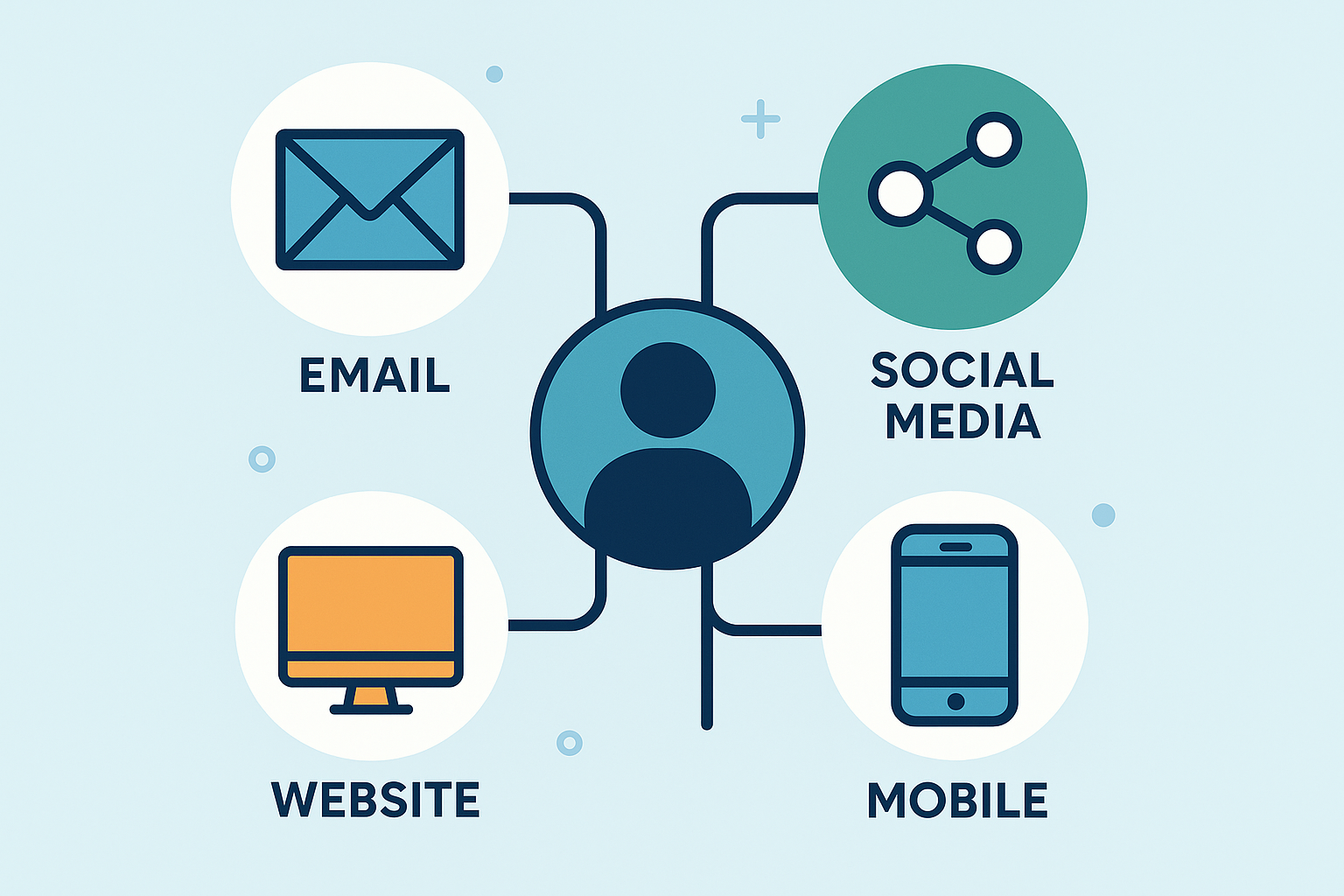In today’s fragmented media landscape, customers interact with brands across dozens of touchpoints—social media, websites, mobile apps, email, physical stores, customer service calls, and more. How businesses orchestrate these interactions fundamentally determines customer experience quality, conversion rates, and long-term loyalty. While the terms “multichannel” and “omnichannel” marketing are often used interchangeably, they represent fundamentally different strategic approaches with dramatically different outcomes. For business owners, startups, and small businesses navigating digital transformation, understanding this distinction isn’t academic—it’s essential for competing effectively in markets where customer experience increasingly determines success.
Defining the Distinction: More Than Semantic Difference
Multichannel marketing involves engaging customers through multiple separate channels—email, social media, website, physical location, mobile app—with each channel operating largely independently. A business might have an active Instagram presence, send regular email newsletters, maintain a website, and operate a retail location, but these channels function as distinct entities with separate strategies, content, and customer data.
Omnichannel marketing integrates all customer touchpoints into a unified, seamless experience where channels work together cohesively. Customer data, preferences, and interactions flow across channels, enabling continuity regardless of how customers choose to engage. The Instagram ad remembers what you browsed on the website. The email references your in-store purchase. The mobile app knows your customer service inquiry. Every channel recognizes you as the same customer with consistent history and preferences.
The distinction centers on integration and customer-centricity. Multichannel approaches are channel-centric—each platform operates according to its own logic and objectives. Omnichannel approaches are customer-centric—all platforms work together to serve unified customer journeys. This fundamental difference in orientation produces dramatically different customer experiences and business outcomes.
Research by Harvard Business Review found that customers who engage with brands across multiple channels spend 10% more online and 4% more in-store compared to single-channel customers. However, truly omnichannel customers—those experiencing seamless integration across touchpoints—demonstrate even stronger behaviors, with some studies showing 30% higher lifetime value compared to single-channel customers.
For small businesses and startups, the omnichannel vision can seem overwhelming, requiring sophisticated technology and substantial resources. However, understanding the principles enables strategic progression from multichannel presence toward omnichannel integration at whatever scale your resources permit. The journey matters more than immediate perfection, and even modest integration delivers measurable improvements.
The Customer Journey Reality: Why Integration Matters
Modern customer journeys rarely follow linear paths. Research shows that B2C customers typically use 6+ touchpoints before purchase, while B2B buyers engage with 10+ pieces of content across multiple channels during decision processes. These journeys zigzag unpredictably—from Instagram to website to email to physical store to mobile app and back again.
In multichannel environments, each touchpoint operates independently, creating friction and repetition. The customer researching products on your website must start over when visiting your physical store because systems don’t connect. The person who called customer service must re-explain their issue in the subsequent email exchange. The mobile app doesn’t reflect the items added to cart on the website. Each channel interaction exists in isolation, requiring customers to repeatedly provide information and navigate disconnected experiences.
Omnichannel integration recognizes these complex journeys and eliminates friction between touchpoints. When a customer adds items to their cart on desktop, those items appear in the mobile app. When they visit a physical location, staff can access their online browsing history and preferences. When they contact customer service, representatives see complete interaction history across all channels. The experience feels cohesive regardless of how the customer chooses to engage.
This integration particularly matters because channel preferences vary by customer segment, task type, and context. Younger customers might prefer mobile apps and social media. Older customers might favor email and phone. Research-intensive purchases might begin online and complete in-store. Routine reorders might happen entirely through mobile apps. Omnichannel strategies accommodate these varying preferences without forcing customers into rigid paths.
For business owners, the implications extend beyond customer satisfaction to operational efficiency. Multichannel approaches duplicate effort as different teams manage different channels with different strategies and separate data. Omnichannel integration enables unified strategies, shared resources, and comprehensive analytics that reveal true customer behavior patterns obscured when viewing channels in isolation.
Technology Infrastructure: The Foundation of Integration
The primary barrier preventing small businesses from implementing omnichannel strategies involves technology infrastructure. True omnichannel marketing requires systems that share data, coordinate messaging, and provide unified customer views across touchpoints—capabilities that historically required enterprise-level investments.
Customer Data Platforms (CDPs) represent the technological heart of omnichannel strategies. These systems aggregate customer data from all touchpoints—website visits, email interactions, purchase history, customer service contacts, social media engagement—into unified customer profiles. Unlike traditional databases that store information in silos, CDPs create single customer views accessible across all systems and channels.
The CDP market has evolved rapidly, with solutions now available at various price points and complexity levels. Enterprise platforms like Segment, Tealium, and Adobe Experience Platform serve large organizations with complex needs and substantial budgets. However, more accessible solutions like HubSpot, Klaviyo, and Mailchimp now offer CDP-like functionality suitable for small and medium businesses at fraction of enterprise costs.
Marketing automation platforms provide the coordination layer that enables consistent, personalized messaging across channels. These systems trigger communications based on customer behaviors, preferences, and lifecycle stages rather than arbitrary broadcast schedules. When a customer abandons a cart, the automation might send an email reminder, display retargeting ads, and trigger a text message discount—all coordinated to feel like a coherent conversation rather than disconnected interruptions.
Point-of-sale systems, e-commerce platforms, customer service tools, and inventory management systems must all integrate with the CDP and marketing automation platform to enable true omnichannel capabilities. This integration allows online browsing history to inform in-store recommendations, in-store purchases to trigger relevant email campaigns, and inventory visibility across all sales channels.
For small businesses beginning omnichannel journeys, the technology strategy should focus on integrated platforms rather than best-of-breed point solutions. Choosing an e-commerce platform with built-in marketing automation, CDP functionality, and point-of-sale integration (like Shopify or BigCommerce) provides better omnichannel foundation than assembling separate specialized tools that require complex custom integration.
Cloud-based SaaS solutions have democratized omnichannel capabilities that previously required six-figure investments. Monthly subscription models make sophisticated technology accessible to businesses of all sizes. The strategic question shifts from “can we afford omnichannel technology” to “which integrated platform best fits our needs and growth trajectory.”
Data Integration and Privacy: Balancing Personalization with Protection
Omnichannel marketing depends fundamentally on customer data integration—collecting, unifying, and activating information about customer preferences, behaviors, and interactions across touchpoints. However, this data collection and usage occurs within evolving privacy regulations and growing consumer concerns about data practices.
The General Data Protection Regulation (GDPR) in Europe, California Consumer Privacy Act (CCPA), and similar regulations worldwide establish customer rights around data collection, usage, and deletion. These regulations require explicit consent for data collection, transparent explanation of data usage, and mechanisms for customers to access, correct, or delete their data. Non-compliance carries substantial penalties—up to 4% of global revenue under GDPR.
Privacy considerations significantly affect omnichannel implementation. The cross-channel tracking and behavioral targeting that enable personalized omnichannel experiences must operate within regulatory constraints and ethical boundaries. Businesses must obtain appropriate consent, provide transparency about data practices, and implement security measures protecting customer information.
However, privacy requirements don’t preclude omnichannel marketing—they simply require thoughtful implementation. Research consistently shows that customers willingly share data in exchange for better experiences, convenience, and personalization. The key involves transparent value exchange: clearly explaining what data you collect, how it improves customer experience, and what controls customers have over their information.
First-party data—information customers provide directly through purchases, account creation, preference centers, and willing interactions—becomes increasingly valuable as third-party cookies and external data sources face restrictions. Omnichannel strategies built on first-party data gathered through direct customer relationships prove more sustainable and compliant than those depending on external data sources or invasive tracking.
For small businesses, privacy compliance need not be overwhelming. Clear privacy policies written in accessible language, simple preference centers allowing customers to control communications, secure data storage practices, and genuine respect for customer preferences satisfy both regulatory requirements and customer expectations. The businesses that thrive treat privacy as competitive advantage rather than compliance burden, building trust that differentiates them from competitors with poor data practices.
Channel Strategy: Which Touchpoints Matter Most
Not all channels provide equal value, and attempting to maintain presence across every possible touchpoint stretches resources while potentially degrading quality. Strategic channel selection based on customer behavior, business model, and competitive dynamics produces better results than presence everywhere.
Research should drive channel strategy rather than assumptions. Where do your target customers actually spend time? Which channels influence their purchase decisions? What touchpoints do competitors emphasize? Analytics from existing channels reveal which drive traffic, engagement, and conversion, while customer surveys clarify channel preferences and frustrations.
E-commerce businesses typically prioritize website, email, social media, and mobile apps as core channels, with potential secondary emphasis on SMS, push notifications, and marketplaces like Amazon. Retail businesses might emphasize physical locations, mobile apps, email, and social media, with website serving supporting roles. B2B companies often focus on website, email, LinkedIn, and content platforms with sales team interactions as crucial touchpoints.
The omnichannel principle applies regardless of channel count. Even businesses operating through just website and email can implement omnichannel principles by ensuring these channels integrate seamlessly—email references website behavior, website recognizes email subscribers and personalizes accordingly, and data flows between systems enabling coordinated customer experiences.
Channel expansion should follow strategic logic rather than trend-chasing. Adding TikTok presence because it’s popular makes sense only if your target customers are active there and the content format suits your brand. Opening physical locations works when customer research indicates demand for in-person experience. Launching mobile apps justifies investment when customer behavior patterns show mobile preference and frequent interaction needs.
For resource-constrained businesses, depth matters more than breadth. Excellently executed integration across three core channels produces better outcomes than mediocre presence across eight poorly integrated touchpoints. Start with channels most important to your customers, integrate them thoroughly, then expand strategically as resources permit and customer behavior justifies additional touchpoints.
Personalization at Scale: The Omnichannel Promise
The primary customer-facing benefit of omnichannel marketing involves personalization—delivering relevant messages, offers, and experiences based on individual customer preferences, behaviors, and contexts. Multichannel approaches typically segment customers into broad groups receiving identical messages. Omnichannel approaches enable individual-level personalization that evolves based on ongoing interactions.
Behavioral triggers enable sophisticated personalization without manual effort. When customers browse specific product categories, automated systems can trigger relevant email recommendations, retargeting ads, and mobile notifications. When customers reach loyalty program milestones, coordinated communications across channels acknowledge achievement and offer rewards. When customers show purchase intent signals, sales teams receive alerts enabling timely outreach.
Dynamic content allows single email templates or web pages to display different content based on recipient characteristics. An email promoting new products might show outdoor gear to customers with outdoor purchase history and electronics to those with electronics history—same email template, personalized content based on integrated customer data.
Predictive analytics leverage machine learning to anticipate customer needs and optimize engagement. These systems predict which products customers might want next, when they’re likely to churn, which messages will resonate, and which channels they prefer. As AI and machine learning capabilities become more accessible, small businesses gain sophisticated personalization tools previously available only to enterprises.
However, personalization requires balancing relevance with privacy concerns. Customers appreciate helpful recommendations based on their interests but feel uncomfortable with overly invasive targeting that seems surveillance-like. The threshold varies by individual and context, but general principles include transparency about data usage, customer control over personalization levels, and using data to genuinely help rather than manipulate.
For businesses beginning personalization journeys, start simple with obvious use cases like abandoned cart recovery, browse abandonment emails, post-purchase follow-ups, and birthday or anniversary recognition. These basic personalization applications deliver measurable results and build foundation for more sophisticated approaches as capabilities mature.
Measuring Omnichannel Success: Beyond Channel-Specific Metrics
Traditional marketing measurement approaches analyze channel performance in isolation—email open rates, social media engagement, website conversion rates. While these channel-specific metrics remain useful, omnichannel strategies require measurement frameworks capturing cross-channel journeys and integrated experiences.
Customer lifetime value (CLV) provides the ultimate omnichannel metric. Rather than evaluating individual channel ROI, CLV measures total customer value across all touchpoints and timeframes. This metric inherently captures omnichannel effects—how integrated experiences increase purchase frequency, average order values, retention rates, and referral likelihood.
Attribution modeling becomes both more important and more complex in omnichannel environments. Which touchpoints deserve credit for conversions? Last-click attribution—crediting only the final interaction before purchase—dramatically undervalues earlier touchpoints that influenced decisions. Multi-touch attribution models distribute credit across customer journey touchpoints, providing more accurate understanding of how channels work together.
However, attribution modeling faces technical challenges as privacy regulations limit tracking capabilities and customers use multiple devices and clear cookies. Probabilistic models and marketing mix modeling provide alternatives when deterministic attribution proves impossible, though with reduced precision.
Cross-channel journey analysis reveals how customers actually move between touchpoints. Which paths lead to conversion? Where do customers drop off? Which sequences prove most efficient? Understanding these patterns enables optimization of channel integration and identification of friction points degrading experiences.
Consistency metrics measure whether customers receive coherent experiences across touchpoints. Do messages align across channels? Does brand presentation remain consistent? Can customers seamlessly transition between channels without starting over? These experiential metrics predict satisfaction and loyalty better than engagement metrics.
For practical implementation, businesses should establish baseline metrics before omnichannel integration, then track how integration affects customer behavior and business outcomes. The measurement framework should balance high-level strategic metrics like CLV with tactical channel-specific metrics that guide operational decisions.
Implementation Roadmap: Moving from Multichannel to Omnichannel
Transforming from multichannel to omnichannel approaches requires strategic planning that balances ambition with realistic assessment of resources, capabilities, and organizational readiness. The following roadmap provides framework for businesses at various stages.
Phase 1 involves audit and strategy development. Document all current customer touchpoints and their integration levels. Map typical customer journeys identifying friction points and opportunities. Evaluate technology infrastructure, data quality, and team capabilities. Develop omnichannel vision and phased implementation plan aligned with business priorities and resources.
Phase 2 focuses on foundational integration. Select and implement core technology platform providing CDP and marketing automation capabilities. Ensure all major customer touchpoints connect to this platform, even if integration is basic. Establish data governance policies and privacy compliance frameworks. Train teams on platform capabilities and omnichannel principles.
Phase 3 involves basic personalization and coordination. Implement simple triggered campaigns like abandoned cart recovery, welcome series, and post-purchase follow-ups. Ensure messaging consistency across channels with coordinated campaigns rather than isolated channel-specific initiatives. Begin testing multi-touch attribution and cross-channel journey analysis.
Phase 4 develops advanced capabilities. Implement sophisticated segmentation and predictive analytics. Deploy dynamic content and advanced personalization across channels. Optimize attribution models and journey orchestration. Expand integration to include customer service, in-store systems, and secondary touchpoints.
Phase 5 pursues continuous optimization. Establish regular testing programs improving personalization algorithms, journey efficiency, and channel coordination. Stay current with emerging channels and technologies. Deepen data integration and expand use cases for customer insights.
The timeframe for this progression varies dramatically based on starting point, resources, and ambition. A small e-commerce business might progress from Phase 1 to Phase 3 in 6-12 months with focused effort. Larger organizations with legacy systems might require years for full transformation. The key involves steady progress rather than revolutionary change that overwhelms organizational capacity.
Common Pitfalls and How to Avoid Them
Organizations pursuing omnichannel transformation encounter predictable challenges. Awareness of common pitfalls enables proactive mitigation strategies.
Technology-first approaches prioritize platform selection and implementation without adequate attention to strategy, process, and organizational alignment. The result involves sophisticated tools that teams don’t fully utilize because strategy and capabilities haven’t developed alongside technology. Solution: Develop clear omnichannel strategy before major technology investments, and ensure implementation includes change management and capability building.
Data quality issues undermine omnichannel effectiveness when customer information contains errors, duplicates, or gaps. Unified customer views built on poor data produce flawed personalization and frustrating experiences. Solution: Invest in data cleanup and governance before attempting sophisticated omnichannel applications. Establish processes maintaining data quality ongoing.
Organizational silos persist when different teams manage different channels without coordination or shared objectives. Marketing, sales, customer service, and retail operations operating independently cannot deliver truly integrated customer experiences. Solution: Establish cross-functional omnichannel teams with shared goals and regular coordination. Align incentives around customer experience rather than channel-specific metrics.
Over-personalization creates experiences that feel invasive rather than helpful. Using data in ways that surprise or unsettle customers damages trust despite technical sophistication. Solution: Test personalization with customer feedback, provide transparency about data usage, and give customers control over personalization levels.
Neglecting measurement leaves organizations unable to demonstrate omnichannel ROI or optimize approaches. Without clear metrics, teams revert to channel-specific KPIs that undervalue integration benefits. Solution: Establish omnichannel measurement frameworks before implementation and ensure analytics infrastructure captures cross-channel journeys.
Small Business Advantages: Competing Through Integration
While omnichannel marketing discussions often center on enterprise capabilities, small businesses possess unique advantages in implementing integrated customer experiences.
Agility enables faster implementation and iteration. Small businesses can select platforms, implement changes, and test approaches without lengthy approval processes or complex legacy system migrations. This speed allows rapid learning and adaptation based on results.
Customer proximity provides deeper understanding of customer needs, preferences, and pain points. Small business owners often interact directly with customers, enabling insights that large enterprises struggle to capture through research. This knowledge informs more relevant and effective omnichannel strategies.
Unified teams eliminate organizational silos naturally. When the same people manage website, email, social media, and customer service, integration happens organically without complex coordination mechanisms. This structural advantage produces coherent customer experiences without sophisticated process engineering.
Technology democratization has made sophisticated omnichannel platforms accessible at affordable price points. Small businesses can implement capabilities that previously required enterprise budgets and IT departments. Cloud-based SaaS platforms with built-in integration eliminate custom development requirements.
Authenticity and personal relationships differentiate small businesses from larger competitors. Omnichannel capabilities that enhance rather than replace human connection play to small business strengths. The local retailer who uses integrated data to provide personalized service combines technological sophistication with personal touch that large retailers struggle to replicate.
For small businesses, omnichannel strategy should emphasize depth of integration across core channels rather than breadth of touchpoints. Excellently executed integration across website, email, and physical location (if applicable) produces better outcomes than mediocre presence across eight poorly coordinated channels.
The Future of Omnichannel: Emerging Trends and Technologies
Omnichannel marketing continues evolving as new technologies, channels, and customer expectations emerge. Understanding directional trends enables strategic positioning for future developments.
Artificial intelligence increasingly powers personalization, prediction, and automation at scale. Machine learning algorithms optimize send times, content selection, channel preferences, and offer targeting without manual rules. Natural language processing enables conversational interfaces across channels. Computer vision allows visual search and augmented reality experiences. These AI capabilities become more accessible and affordable, enabling sophisticated omnichannel applications for businesses of all sizes.
Voice interfaces through smart speakers and digital assistants represent emerging touchpoints requiring integration into omnichannel strategies. Voice shopping, customer service, and information seeking create new customer journey elements. Businesses must consider how voice interactions integrate with traditional digital and physical channels.
Augmented reality (AR) bridges digital and physical experiences, enabling customers to visualize products in their environments before purchase. Furniture retailers let customers see how sofas look in their living rooms. Cosmetics brands enable virtual makeup try-ons. These experiences integrate with other touchpoints—products discovered on social media, viewed through AR, purchased through e-commerce, and delivered to physical locations.
Internet of Things (IoT) devices generate customer data and create new interaction opportunities. Connected appliances can automatically reorder supplies. Wearable devices provide health and activity data enabling personalized recommendations. Smart home systems integrate with retail experiences. These IoT touchpoints expand omnichannel ecosystems beyond traditional screens.
Privacy-first approaches will increasingly define omnichannel capabilities as regulations tighten and consumer awareness grows. The businesses that build trust through transparent, ethical data practices and deliver genuine value in exchange for data will maintain competitive advantages over those pursuing aggressive tracking and targeting.
Conclusion: The Competitive Imperative of Integration
The distinction between multichannel and omnichannel marketing represents far more than semantic difference—it reflects fundamental strategic choices about customer experience, technology investment, and competitive positioning. As customer expectations for seamless, personalized experiences across touchpoints continue rising, omnichannel capabilities transition from competitive advantage to competitive necessity.
For business owners, startups, and small businesses, the omnichannel journey need not be overwhelming. Success doesn’t require immediate implementation of enterprise-level sophistication across dozens of touchpoints. Rather, it requires commitment to integration principles—unified customer data, coordinated messaging, seamless channel transitions, and customer-centric rather than channel-centric thinking.
The businesses that thrive in increasingly complex digital landscapes will be those that make omnichannel integration strategic priority. They’ll invest in platforms enabling data integration, develop teams capable of coordinated execution, and continuously optimize based on customer behavior and feedback. They’ll balance technological sophistication with human connection, personalization with privacy, and efficiency with authenticity.
The question isn’t whether to pursue omnichannel integration but rather how quickly and effectively you can evolve from multichannel presence toward integrated customer experiences. Your customers already operate omnichannel in their behavior—engaging across multiple touchpoints and expecting seamless experiences. The only question is whether your business will meet these expectations or cede advantage to competitors who do.
Start where you are with resources you have. Audit current integration levels, identify highest-value opportunities for improved coordination, and implement incremental improvements that compound over time. The businesses that begin this journey today position themselves for sustainable success as customer expectations and competitive dynamics continue evolving toward seamless, integrated, truly omnichannel experiences.
References
- Baxendale, S., Macdonald, E.K., & Wilson, H.N. (2015). “The Impact of Different Touchpoints on Brand Consideration.” Journal of Retailing, 91(2), 235-253.
- Bell, D.R., Gallino, S., & Moreno, A. (2018). “Offline Showrooms in Omnichannel Retail: Demand and Operational Benefits.” Management Science, 64(4), 1629-1651.
- Brynjolfsson, E., Hu, Y.J., & Rahman, M.S. (2013). “Competing in the Age of Omnichannel Retailing.” MIT Sloan Management Review, 54(4), 23-29.
- Gallino, S., & Moreno, A. (2014). “Integration of Online and Offline Channels in Retail: The Impact of Sharing Reliable Inventory Availability Information.” Management Science, 60(6), 1434-1451.
- Neslin, S.A., Grewal, D., Leghorn, R., Shankar, V., Teerling, M.L., Thomas, J.S., & Verhoef, P.C. (2006). “Challenges and Opportunities in Multichannel Customer Management.” Journal of Service Research, 9(2), 95-112.
- Piotrowicz, W., & Cuthbertson, R. (2014). “Introduction to the Special Issue Information Technology in Retail: Toward Omnichannel Retailing.” International Journal of Electronic Commerce, 18(4), 5-16.
- Shen, X.L., Li, Y.J., Sun, Y., & Wang, N. (2018). “Channel Integration Quality, Perceived Fluency and Omnichannel Service Usage: The Moderating Roles of Internal and External Usage Experience.” Decision Support Systems, 109, 61-73.
- Verhoef, P.C., Kannan, P.K., & Inman, J.J. (2015). “From Multi-Channel Retailing to Omni-Channel Retailing: Introduction to the Special Issue on Multi-Channel Retailing.” Journal of Retailing, 91(2), 174-181.
- von Briel, F. (2018). “The Future of Omnichannel Retail: A Four-Stage Delphi Study.” Technological Forecasting and Social Change, 132, 217-229.
- Zhang, M., Ren, C., Wang, G.A., & He, Z. (2018). “The Impact of Channel Integration on Consumer Responses in Omni-Channel Retailing: The Mediating Effect of Consumer Empowerment.” Electronic Commerce Research and Applications, 28, 181-193.
Additional Resources
- Harvard Business Review – Retail and Consumer Goods: https://hbr.org/topic/retail-and-consumer-goods – Research and case studies on omnichannel retail strategies
- Shopify Blog – Omnichannel Commerce: https://www.shopify.com/blog/omnichannel-retail – Practical guides for implementing omnichannel e-commerce strategies
- Salesforce Research – State of the Connected Customer: https://www.salesforce.com/research/customer-expectations/ – Annual research reports on customer expectations across channels
- BigCommerce Resources: https://www.bigcommerce.com/articles/omnichannel-retail/ – Educational content on omnichannel strategy and implementation
- Google Think with Google: https://www.thinkwithgoogle.com/consumer-insights/ – Consumer behavior research including cross-channel journeys
- Gartner for Marketing Leaders: https://www.gartner.com/en/marketing – Research on marketing technology and customer experience strategy
- MarketingProfs: https://www.marketingprofs.com – Practical marketing strategy content including omnichannel approaches
- Customer Experience Professionals Association: https://www.cxpa.org – Resources on customer experience design and omnichannel journey mapping




